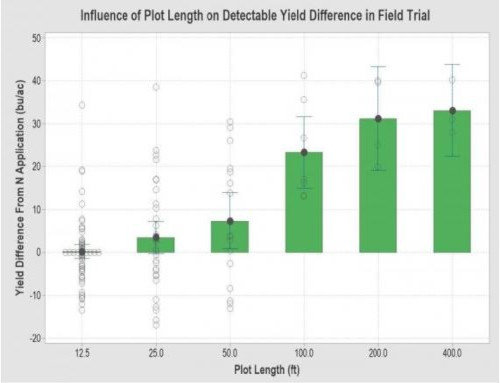Figure 1. Treatment plots with lengths of 12.5 feet, 25 feet, 50 feet, 100 feet, 200 feet and 400 feet were created to measure the minimum treatment size to maintain accurate yield data. The width of each block is 30 feet. Green areas received the 50 lbs. pre-plant plus 150 lbs. sidedressed and red blocks only received the 50 lbs. pre-plant.
Yield data was analyzed by comparing the difference in neighboring nitrogen treatment zones. While we would expect there to be a positive yield difference in the nitrogen rich strips, this was not always the case. Specifically, in the short treatment strips, the grain flow from the high and low nitrogen treatments was mixed within the combine harvesting process and no measurable yield difference was detected. A plot length of 100 feet was required to achieve a statistically significant non-zero yield difference between the nitrogen treatments (Figure 2). The difference was consistent and most pronounced when using plot lengths of 200 feet or greater.

Figure 2. A plot size of 12.5 feet showed no difference in yield between the two treatment areas, while the 400-foot plot showed a difference of more than 30 bushels per acre.
With very small areas, the large amount of grain the combine is processing limits the ability to determine differences in the yield data. This is important when you’re changing treatments along the length of a field, but also during hybrid trials when you may be only taking a half width of the combine head or the plot is much shorter than the length of the field.

Figure 3. Normalized yield comparison between two nitrogen treatments implemented based on the length of the treatment strip. At plot lengths less than 100 feet the combine yield monitor is not able to differentiate yield response treatment differences. At 200 feet or greater the combine can consistently measure the treatment response.
These spatial data constraints should be considered when designing field trials for the upcoming season. Experimental trials in strips across the full length of the field are preferred in most cases to provide enough space for the combine to accurately measure treatment results. Experimental blocks can also be used if they are large enough and if the length of travel within the plot is greater than the minimum required length. The use of experimental block designs is necessary in some cases, like test programs in soybeans where the crop is harvested at a different angle than it was planted. If using this design, a minimum block size of two acres or greater is recommended.
Source : iastate.edu